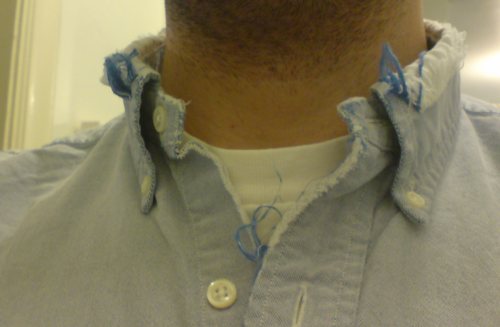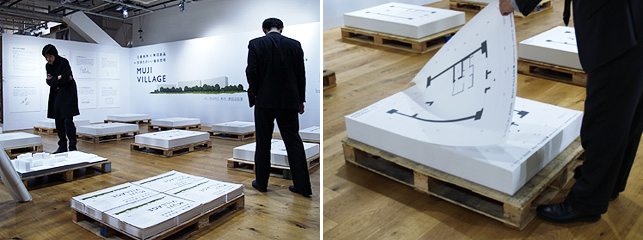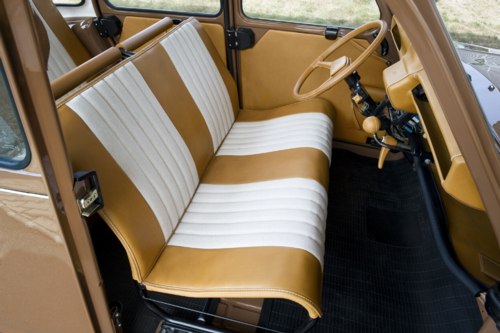Do not adjust your speakers. After hearing Bill Cunningham narrate his photos from the Inauguration, I don’t know how I ever got by just looking at the newspaper. [nyt]
Category: etc.
A Prophetess Has No Honor In Her Own Five Towns
The only thing worse than daytrippers is being one.
Every week, we’d drive into the city, parking our cars in another section each time and walking till our legs gave out. It was revitalizing just to see the differences! The differences in buildings, people, stores, sidewalks, streets. We’d spend hours in a strange food store, choosing things to take back home. Often, we’d strike up a conversation with the people we’d meet. Negroes. Puerto Ricans. Italians. I felt I was part of the world again!
One Woman’s Confession: I HATE SUBURBIA (Lady’s Circle, Sept 1965) [modernmechanix.com via city of sound]
Boro Boro

I just have get this out there, even though I know it drives Jean quietly crazy. I like wearing clothes with holes in them. I just do. Not cutouts, obviously, and not really rips, but stuff that wears out, wears through.
I don’t know when exactly it started, but I have some clues, and I suspect Rei Kawakubo bears a lot of the blame, even though my Comme des Garcons is in great shape. And it’s not entirely her fault, because I know I was holding onto at least one wonderful cashmere sweater I bought at the opening of Fellissimo on 56th street which got a hole in it the middle of the chest just a couple of years after I bought it, and that was before I bought The Shirt.
The Shirt is this blue CdG dress shirt that’s plain in every way, except that it has wrinkles permanently pressed into the lower half of the sleeves. There’s no better way to really get to know your dry cleaner–and to have him remember you–than to bring him a shirt that must be ironed in such a way that the wrinkles don’t disappear. It’s over ten years, and The Shirt is still properly wrinkled, and I think the conscious choice of buying and flaunting, frankly, a piece of disheveled clothing helped pull me over the line between not throwing out something [expensive/comfortable] I liked and wearing something with a hole in it, even if I looked like a hobo.
The Fellissimo sweater was a start, but the real foundation of my shredded wardrobe is a Ralph Lauren blue buttondown oxford shirt [pictured], which I wear with something akin to cheapskate preppy pride. It’s almost 20 years old, and the collar and cuffs have been ragged for at least the last 5-6 years. Everything else about the shirt is solid–oh wait, no, the left elbow wore through last fall, a result of my typing posture. It’s happened on a couple of great sweaters recently, too.
But I think the point the shirt makes [to me] is clear: I’m not going to replace this shirt. First off, there is no way in hell I’d buy a blue buttondown oxfordcloth shirt at Ralph Lauren today, in 2009. Ralph and I have both traveled too far, and it is just not the same thing. [And it’s not some Made in USA, not Sri Lanka problem, either. I think mine was made in Hong Kong. And it’s not like I’d ever buy a vintage shirt, shredded by someone else. Maybe if it was deadstock, but who’s got time to hunt down vanilla 1980’s Ralph Lauren shirts these days?]
In the last few months, I found an old white Ralph Lauren oxford in a box of clothes I’d packed and stored after business school. I put it into heavy rotation, and now it, too, is starting to fray along the collar.
One shirt with a scraggly collar might make people wonder–don’t worry–if I didn’t notice, or worse, maybe that’s the only shirt option I had. But put a cashmere sweater with a worn out elbow over it, and they’ll have to know it’s a choice. Not that they’ll know what to make of it.
The real holey clothes, then, are the cashmere sweaters. I have 30- and 40-year-old cashmere sweaters that look brand new, and I have 4-year-old sweaters that are falling apart. [Cashmere has really diminished since it went mass market a while back, and paying a lot for it is no guarantee of quality or durability. It’s really a shame.] But worn-through cashmere feels kind of nostalgic, I guess, not just too expensive or wasteful to toss out.
Up until World War II or so, dirt poor Japanese farmers used to save every scrap of fabric they could get their hands on, repairing and reusing indigo-dyed cotton and linen with great care. The Japanese term for worn out, boro boro, has since become its own aesthetic, and the more intricately patched and repatched the futon cover or jacket is, the more highly it’s prized.
I get it, but that’s not quite where I am yet, I think. For one thing, I haven’t figured out any strategy to mend any of my holey sweaters. They’re all too far gone for the French-American Reweaving Company to do anything about them, though they do excellent work repairing snags or the occasional moth hole. Really great work. But mending something or reworking it, or patching it, is a conscious move; it’s doing something about the holes instead of just letting them be. I think I’d rather be comfortable and content to let the clothes run their course.
But for the question of why I bring this up at all: I think wearing clothes with holes in them is going to be increasingly popular over the next couple of years, and I just want it to be clear that I was doing it first.
Muji Village: “Green, Plain, Community”

Muji has teamed up with real estate developer Mitsubishi Chiso [Mitsubishi Estate] to create Muji Village, a three-building condominium complex in Chiba Prefecture, the New Jersey of Tokyo. Or maybe it’s the Westchester of Tokyo, and Saitama’s New Jersey, but still. [here’s a Google map of the site. It’s near Maebara and Tsudanuma stations, and it used to contain a six-building municipal housing complex from 1960.]
The concept for Muji Village boils down to three points: Green, Plain, and Community. Green means trees, not ecologically sustainable. Plain means “white, 100 year concrete” and design that won’t go out of fashion [sic], plus flexibility to remodel as your family configuration changes, and Community means common spaces like libraries and a couple of gardens.
Frankly, even though Muji is pervasive to the point of saturation in Japan, I’d still suspect that Muji Village is being built on the premise of a particularly brand-centric “feel good lifestyle,” and that it is intended to attract like-minded Muji aficionados–Mujillas in this case, not Mujillahs.

Last month at the flagship store in Yurakucho, Muji Atelier exhibited poster-sized Muji Village floorplans in a grid of stacks on the floor. They were meant for you to roll up and take home, so you could discuss them at your kitchen table and decide the layout you preferred best. Such presentation, such collaborative spirit, such freedom of choice! It’s as if Muji Village’s exclusive broker was Felix Gonzalez-Torres.
I can’t find any info on prices, or photos, or renderings. And yet the Muji Village website says they are currently looking, not for buyers, but for “members.”

update: Aha, here it is. 9 stories, 152 units, Sounds like Mitsubishi came with an existing project. Muji’s doing the exterior, unit interiors, and common areas, including the Community “living rooms.” Sales and model room debut in late January for Feb. 2010 occupancy. [via nikkei business preess, sept. 08, before the real estate development world ended]
Muji Village info page and exhibition [muji.net]
Muji Village website [muji-village.com]
The Fake Wedding Singer
Even he had to admit that this was as pleasant a concert setting as could be imagined. The stage was a flatbed trailer set up in front of a log cabin; it was a breezy summer afternoon, and people brought folding chairs and beach blankets. His mother was there, with a collection of aunts and uncles. Parsons, shirtless in swimming trunks and as skinny as advertised, sang some charming, shambling mountain songs with his band, and then there was a fake marriage ceremony, in case the neighbors were watching–they had been told that the gathering was for a wedding, on the theory that this would make them less likely to call the police. Then Oldham took the stage, with Parsons and the band surrounding him. He was wearing a maroon tank top, orange-and-pink pants, blue Crocs, and a pink Boston Red Sox cap, with “cam” and “odia” scrawled on either side of the “B.”
– Will Oldham transfigures American music, by Kelefah Sanneh [newyorker.com via southwillard]
Donate To ArtFagCity’s Year-End Pledge Drive
Paddy Johnson does great work at AFC. By contributing today–right now, in fact–you can help support the expansion online of art, its creation, exhibition, and its thoughtful interpretation. And thanks to her collaboration with Momenta Art to manage AFC’s fundraising and the appropriate, non-profit use of the proceeds, your contribution is tax-deductible.
details, discussion, and donation: The Art Fag City Year-End Fundraiser: the final stretch [artfagcity.com]
Fuller x Noguchi Colabo: Dymaxion Car Model

In what has apparently become an annual feature here on greg.org, I present Rare And/Or Unique Buckminster Fuller Objets. This time last year, it was the Perspex prism chandelier Fuller [had] made as a wedding gift for Princess Margaret. The 2nd item:
A rare, early model of the Dymaxion vehicle, circa 1932, carved by Isamu Noguchi and painted by Fuller. Fuller and Noguchi had met in New York, and began working together on the Dymaxion House. The Vehicle, which was to be a car/plane/whatever eventually followed.
The model had been published many times over the years, but until very recently, it was believed to be lost. Neither the 2006 Noguchi Museum exhibition, “Best of Friends” nor the Whitney’s recent Fuller retrospective are mentioned in the model’s Sotheby’s exhibition history, so I suspect their publicity helped flush it out of hiding. Which makes it a recent discovery indeed.
Important 20th Century Design, Dec. 18, 2008, Sotheby’s New York
LOT 145: R. BUCKMINSTER FULLER AND ISAMU NOGUCHI
AN IMPORTANT AND RARE “DYMAXION” CAR MODEL, est. 40,000–60,000 USD [sothebys]
update: it sold for $92,500.
Costco
So we go to Costco for lunch and formula Friday, my dad, the kids and I, and it’s a flatscreen frenzy. Like Rodney King-grade looting frenzy; every cart has a flatscreen and a bale of toilet paper, and I’m like, I have a flatscreen I don’t even watch, and yet I want another one. I couldn’t fit that box in the car, and I still want one. My dad and his wife bought the biggest flatscreen in the Triangle last spring, and I can see he wants one, too.
The kid’s sitting in the cart, and she sees a guy carrying a 19″ flatscreen, and she goes, “Look! He has a tiny one!” and the guy looks at her, looks at the box–I’m not making this up, my dad told me; he was investigating the flatscreen aisle while I was in the bathroom–and goes and puts it back, and picks up a 23″ flatscreen.
So I go over to the palettes of Vizio 37″ and 42″ screens, and they are indeed rather low-priced: like $599. And so I turn to the guy with two 42’s in his cart who’s helping a woman put a 37 in her cart, “What’s going on?” And he’s all, “I’ve got two.” “But is there a special?” And he rustles through a Costco mailer of some kind, trying to show me the $100 off while supplies last! coupon, and he finally just says, “It’s another $100 off today,” and points at the $599 sign, “so it’s like $400!”
Seriously not needing anymore flatscreens, and being of such an age and technological sophistication that I only buy flatscreens that pass the, “But how does it look if I drop 250,000 rubber balls down a San Francisco hill?” test, I decide I’m not going to spend a thousand dollars on three flatscreens from Kirkland or whoever, we go buy an entire office partyful of Brie instead, a 550g wheel which, embarrassingly, is almost gone not 4.5 days later.
But here’s the thing about buying a 3lb jar of Skippy [1] peanut butter. No one has a knife long enough to reach the bottom, and you can’t just toss it out and open the other 3lb jar it was shrinkwrapped together with, because a) there’s like a depression or something in the news, b) why go all the way to Costco to save 50 cents on a year’s supply of peanut butter if you’re just going to toss it, and c) in fact, that blob down there is actually like half a regular jar from the deli; it only looks like a small amount because it’s at the bottom of a peanut butter bucket.
Wait, so the knife. No knife that can reach the bottom, so you have to stick your hand in there, and you get peanut butter all over your knuckles, because it’s not like you are actually going to get a rubber spatula out–you’re not baking a cake here, just making a breakfast snack–to make a freaking PBJ, which you’ve already psyched yourself into, so you don’t want to screw it and open the microwave-sized box stuffed with the pillow-sized bags of Honey Nut Cheerios instead. And now that you think about it–i.e., right after you centrifuge and shake and coax the last splurge out–why don’t they have squeezable half-gallon size bottles of Welch’s grape jelly? Not that you have any room in the fridge, unless you finally get rid of that almost-full gallon of lingonberry juice concentrate, like you’d ever be away from Ikea long enough to actually develop a lingonberry jones.
[1] whoops, it was Jif.

To Shop: Reference Library @ Kiosk, Nov. 28 – Dec. 7

If you shop at only one blogger-curated pop-up store this holiday season, make it Andy Beach’s Reference Library Mini-Exhibition at Kiosk in SoHo.
Despite his fame as a retail artist/design guru/dad/ex-DT guest blogger is probably best known for his invention of the “things I didn’t win on eBay” tag.
Among the dozens of items on sale starting tonight through Dec. 7th: select vintage finds that Andy did win; stuff for kids; union-printed posters; art; and custom manufactured limited editions by artisans around the world.
Kiosk Mini-Exhibition #8: Reference Library [referencelibrary]
Kiosk main page [kioskkiosk.com]
Star Wars Toasted, With Extra Cheese

I know there’s really no other way for Lucas & co to justify the existence of a Darth Vader Toaster than to just embrace the idiocy and hang on for dear life, but still. Holy smokes:
If there’s something every Sith Lord knows how to do it’s make a balanced breakfast. While the Jedi have to live off of Jawa juice and fried nerfsteak, the Dark Lord of the Sith prefers to have a reminder of his fiery Mustafar defeat at his breakfast table. Every morning he burns that moment into a slice of bread with the Darth Vader Toaster. This black, ominous kitchen appliance easily leaves the mark of Vader’s helmet in every yummy piece of toast. Slather some Bantha butter on top, or make two pieces for an extra-Sithy BLT. Force power not required to operate toaster.
I imagine the $48/toaster gross margin helps ease the conscience as well.
Darth Vader Toaster, $54.99, pre-order for Jan. 2009 delivery [starwars.com via c-monster]
You Better Hold On, Meet You In Tompkins Square
In 1988, a police riot broke out at Tompkins Square Park in the East Village. Police beat, among others, people defying a 1 AM curfew imposed by Mayor Ed Koch in an attempt to curtail, among other things, late night music performances.
Last night, twenty years later, the residents of St. Marks and Avenue A had their sleep disrupted once again by an impromptu performance at 2 in the freakin’ morning. Fortunately, the incident was caught on tape. [via sullivan]
I Shouldn’t Have Said Anything.
This morning I was buying a Diet Coke at the gas station, which forced the lady to get up from her chair by the radio.
“Arlo Guthrie! I didn’t even know he was still alive!”
“Really! You know who I’m always amazed to hear is still alive,” I said, trying to match both the tenacious age and the names’ quirkiness and rhythm as closely as possible: “Studs Terkel.”
Studs Terkel dies [chicagotribune]
Studs spoke at the Printers Row Book Fair in June [chicagopublicradio.org]
I Love Paris In The Quarries
Spectacular. ITV took an underground tour of Paris with l’UX and the folks from Untergunther. They started in the sewer, went deeper into the quarries that provided the stones from which medieval Paris was built, and ended up–well, I’ll let you see yourself where they watched the sunrise from. [thanks for the tip, lazar!]
previous explorations of the explorateurs urbains of l’UX, Untergunther, and la Mexicaine de Perforation from greg.org
Citroen 2CV x Hermes Mashup

It’s like unfinished project night around here. Hermes unveiled its reskinned a 1989 Citroen 2CV6 Special at the Paris Auto Show to commemorate the 60th anniversary of the Deux Chevaux. Not that anyone needs a reason to luxe out a 2CV, of course.
All the plastic dash and door panel elements have been outfitted in stitched Hermes leather; the rubberized roof has been replaced with Hermes canvas, and the seats–which are removable, remember, and could thus be used in a pinch as picnic or beach furniture–were recovered in leather and canvas. The whole thing was given a paint job that probably cost as much as the donor car itself.

This is pretty close to what I planned to do when I bought my 2CV Charleston in 1995. At the time, I was a pretty heavy Ghurka customer, and I had become friends with the executives and owners of the Connecticut-based company. They had just begun a furniture upholstery sideline a couple of years before, so they were pretty amenable to my request to redo my 2CV seats in Ghurka saddle leather. Rather than bring the seats–or the car–from France to Connecticut, we figured it’d be easier to ship the hides to an upholsterer in France.
Which is where the project died. Ride-pimping culture was not too prevalent along the Cote d’Azur. The carrosserie folks I contacted in Monaco were extremely uninterested in working on an insignificantly scaled project on a dumpy little car like a 2CV. But the Citroenistes were even worse. “No. A Charleston seat is grey, quilted tissu,” said the indignant Citroen upholstery specialist when I asked him about recovering my seats.
So I kept the seats I had, but I added a bamboo sunshade on the roof, which, I’ll point out, the Hermes 2CV does not have.
Paris 2008: Citroen 2CV6 by Hermes [autoblog]
Looks Like I Picked The Wrong Week To Give Up Fashion, Uh, Week
From the AP Bureau in Utterly Incongruoustan:
Paris designers defy economic woes
Filed at 11:34 p.m. ET
PARIS (AP) — As retail stocks plunged on Monday, Paris designers came up with antidotes to the economic blues plaguing the luxury industry.
British designer John Galliano tapped tribal influences in his ready-to-wear show for Christian Dior. Yohji Yamamoto created a haven for Zen contemplation, while Vivienne Westwood had simple advice for fashion addicts hit by the downturn: do it yourself!
French fashion label Cacharel celebrated its 50th anniversary as the Dow Jones index lost nearly 800 points.
I’ll let you know when this headline is changed to “Paris designers blindsided and rendered ridiculously irrelevant by economic woes”.
AP EU France Fashion Week Day 1 [ap/nyt]
